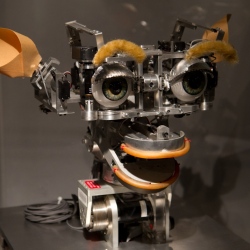
A new bomb disposal robot developed at the Johns Hopkins University Applied Physics Laboratory (APL) is blurring the line between advanced prosthetics and robotics. Rather than building arms and hands from scratch specifically for the robot, the Bimanual Dexterous Robotics Platform (BDRP) is equipped with artificial limbs designed for amputees. The combination is relatively unique, and provided the team with a secondary use for the Modular Prosthetic Limb (MPL) it developed for the DARPA Revolutionizing Prosthetics program.
The BDRP (aka Robo Sally) has always been equipped with a pair of cameras for a head and prosthetic arms, but it has gone through a number of changes since it was first unveiled in 2008. Originally balancing on a Segway-like mobile platform with just two wheels, it now motors around on four wheels to better tackle uneven terrain. The bulk of its electronics have also been moved to the back seat, considerably slimming its figure.
Altogether the robot has 42 degrees of freedom, with three in the neck, three in the torso, two in the mobile platform, and the rest located in its pair of prosthetic arms and hands, which sport 17 apiece. Thanks to its scalability, the MPL can contain fewer moving parts than the version for amputees (which has a total of 25), making it less expensive to replace in the event an inspection goes boom.
